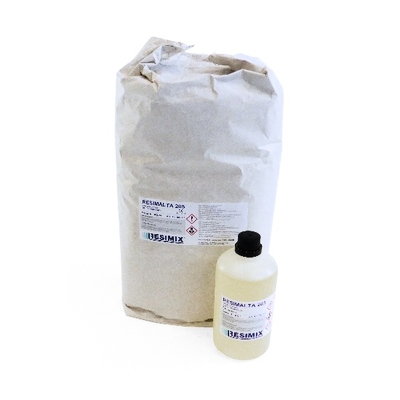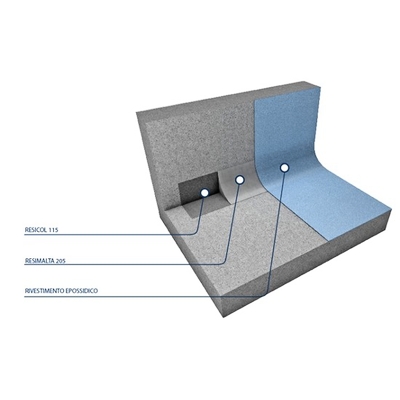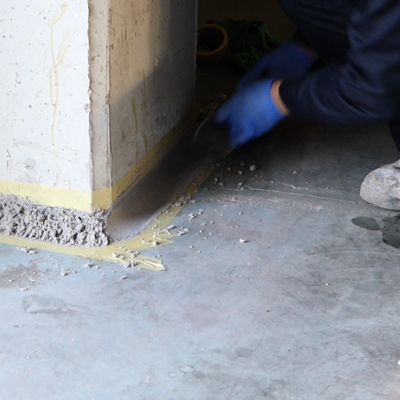RESIMALTA 205
THIXOTROPIC EPOXY MORTAR FOR MENDING AND RESTORATIONS
Closed porosity (self-sealing), high strength, non-shrink, thixotropic, two component epoxy mortar. Recommended for structural horizontal and vertical restoration at low, medium and high thicknesses, and for making joints.
- Very high mechanical resistances;
- High resistance to abrasion and collisions;
- Solvent-free;
- Possibility to carry out low thickness and high resistance restorations;
- Excellent resistance to the aggression of acids, alkali and solvents;
- Excellent adhesion to concrete, bricks, stone, wood, iron following application of RESICOL 115 primer;
- Good waterproofing;
- Excellent workability also on vertical surfaces and overhead;
- It hardens with no shrinkage on high and low thicknesses;
| Technical characteristics | U.M. | |||||||||||||
|---|---|---|---|---|---|---|---|---|---|---|---|---|---|---|
| Compression strength (1 day) | 40 | N/mm2 | ||||||||||||
| Compression strength (7 days) | 65 | N/mm2 | ||||||||||||
| Bending strength (1 day) | 10 | N/mm2 | ||||||||||||
| Bending strength (7 days) | 25 | N/mm2 | ||||||||||||
| Elastic modulus | 14500 | N/mm2 | ||||||||||||
| Density | 2,04 | Kg/dm3 | ||||||||||||
| A + B mixture ratio | 100 + 4 |
Hardening after 7 days at 23 °C
| CHEMICAL RESISTANCES | 7 | 14 | 21 | 28 | ||||||||||
|---|---|---|---|---|---|---|---|---|---|---|---|---|---|---|
| Deionized water | 0 | 0 | 0 | 0 | ||||||||||
| Seawater | 0 | 0 | 0 | 0 | ||||||||||
| 10% Sulphuric acid | 0 | 0 | 1 | 1 | ||||||||||
| Hydrochloric acid 10% | 0 | 0 | 1 | 1 | ||||||||||
| Hydrochloric acid 30% | 0 | 1 | 1 | 1 | ||||||||||
| Phosphoric acid 10% | 0 | 0 | 1 | 1 | ||||||||||
| sodium hydroxide 20% | 0 | 0 | 0 | 0 | ||||||||||
| Ammonia 10% | 0 | 0 | 0 | 1 | ||||||||||
| Ethanol 20% | 0 | 0 | 0 | 0 | ||||||||||
| Diesel | 0 | 0 | 0 | 0 | ||||||||||
| Acetic acid | 1 | 2 | 3 | - |
Preparation of the basement
The surface to be treated must be clean, healthy, dry and mortar grout and crumbly part-free. Best adhesion is achieved by roughening it by sandblasting.
Application on metals follows careful preparation of the support: remove oils, fats, varnishes and rust by abrading or sandblasting with white metal (SA2 – SA 3 degree).
After sand-blasting, vacuum the dust and then apply RESICOL 115 epoxy primer both on the concrete and on the armour rods if they happen to be exposed.
Preparation of the product
Pour component B into component A and blend at slow speed for 3’ – 5’ using drill with helix/spiral to reduce air inlet as much as possible; during this operation, scrape also the bottom and the sides of the bucket; the mortar must be even before application.
Application
Apply the mortar on the primer, layer upon layer, within the times of use (see table) with trowel, palette knife or other suitable tool based on the type of work to be done.
RESIMALTA 205 may be applied with low or high thicknesses with no hardening or shrinkage problems. In case of thicknesses greater than 3 cm applied on vertical or overhead surfaces we recommend supporting the mortar with a board or formwork until it hardens.
Notes
Packages are weight pre-measured out: fully use all components A and B. If you wish to divide the package, products must be weighed by respecting the A+B ratio on the label and must not be weighed out based on the volume.
Three essential rules are valid for all bi-component systems: weigh well, carefully mix bottom and walls, observe times of use.
By pouring B component into A component, the hardening reaction starts: following mixture the time
available is limited and it depends on the temperature.
| TEMPERATURE | POT LIFE | HADERNING | ||||||||||||
|---|---|---|---|---|---|---|---|---|---|---|---|---|---|---|
| 10 °C | 80' | 8 hours | ||||||||||||
| 20 °C | 50' | 6 hours | ||||||||||||
| 30 °C | 25 - 30' | 4 hours | ||||||||||||
| 40 °C | 15' | 3 hours |
Full hardening is achieved after 7 days.
Primer RESICOL 115: 0.4 – 0.6 kg/m²
The consumption to create a new layer 1 cm thick with RESIMALTA 205 is approx. 20 kg/m².
Available in 10kg and 25 kg packages (A + B component).
RESIMALTA 205 remains unaltered for at least a year in a dry and sheltered place, at a temperature from
+10°C to +30°C in its original sealed containers.
- Mending of concrete, brick and stone structures;
- Restoration of holes and unevenness in cement industrial floors;
- Execution of connecting bases in the corners between walls and floors;
- Restoration of concrete for high chemical protection interventions;
- New layers with medium-high thickness to create new inclinations;
- Restoration of chipped joints in industrial floorings;
- Restoration of corners, steps, low walls, balconies, concrete skirting boards;
- Execution of layered surfaces subject to chemical aggression and mechanical abrasion;
- Hollow filling and scarification due to the formation of armour rust and mechanical action performed
by sandblasting machines and bushhammering;





